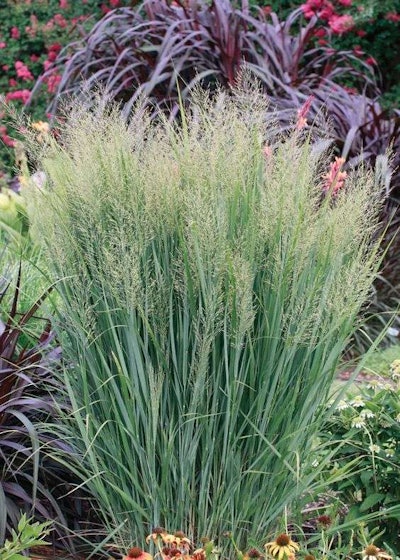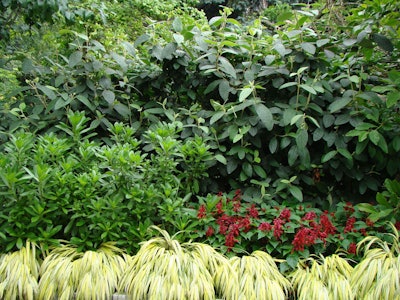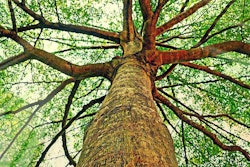 Maiden grass is low-maintenance and deer resistant.
Maiden grass is low-maintenance and deer resistant.Photo: Jan Johnsen
Ornamental foliage can offer an unlimited number of design options in the landscape, but one of the best choices is creating privacy screens with them.
People enjoy having backyard escapes and sometimes a fence or other solid barrier detracts from the desired atmosphere. This is where living screens come in. These green walls are less confining and can be spread out so neither sunlight nor the view is completely blocked.
Depending on what plants are chosen, your clients can enjoy evergreen screens or three seasons of color. The location of what needs to be screened can also be used to determine whether an evergreen or deciduous plant would work better.
Most people want their green wall serving as a boundary around the property, but the walls can also be placed in certain areas of the yard. For example, the screens can be grown around patios to make them more intimate or by pools to create an oasis feel. Plant selection, of course, will depend on the application.
 Northwind switchgrass is hardy in USDA Zones 4-9.
Northwind switchgrass is hardy in USDA Zones 4-9.Photo: Monrovia
“You don’t want deciduous plants around the pool because, come fall, those leaves get in the pool,” said Roger B. Seely Sr., horticulturalist and owner of Seely’s Landscape Nursery based in Hilliard, Ohio.
A better option to place around a pool or hot tub is ornamental grass such as Northwind switch grass (Panicum virgatum ‘Northwind’) or Karl Foerster feather reed grass (Calamagrostis x acutiflora ‘Karl Foerster’).
“My number one plant for screening would be Northwind,” said Jennifer Brennan, a horticulture information specialist for Chalet Landscaping, Nursery, & Garden Center in Wilmette, Illinois. “It has phenomenal vertical foliage that you can mass together as a screen. The only disadvantage is you have to cut them back in March.”
Another ornamental grass that works well as a privacy screen is maiden grass (Miscanthus sinensis ‘Gracilliumus’). This grass grows 6 feet high and has a vase-like shape.
“Although not normally thought of as screening plant, it can stand throughout most of winter to provide architectural interest and privacy,” said Jan Johnsen, owner of Johnsen Landscapes & Pools and author of Heaven is a Garden.
If the client is looking for a shield of green around their property, evergreens like Green Mountain boxwood and Emerald Green arborvitae are good standbys. Both grow at a moderate rate.
For those wanting a faster-growing hedge with some variety in color, red tip photinia (Photinia x fraseri) is a good option.
“Ligustrum and red tip photinia both create very dense hedges,” said Kristin Braud, office manager for Plant Tech Nursery & Landscape in Baton Rouge, Louisiana.
New growth on red tip photinia comes in bright red for spring and then matures to dark green leaves. To prevent against entomosporium leaf spot, ensure the plants have plenty of spacing; crowding them can increase their susceptibility to disease.
 Leatherleaf viburnum berries start out red in the fall and then turn black when ripe.
Leatherleaf viburnum berries start out red in the fall and then turn black when ripe.Photo: Jan Johnsen
For larger landscapes, sometimes green giants are needed. Johnsen suggests a combination of doublefile viburnum (Viburnum plicatum tomentosum ‘Mariesi’) and leatherleaf viburnums (Viburnum rhytidophyllum ‘Allegheny’).
Doublefile can grow about 10 feet high and 15 feet wide, while leatherleaf can grow 10 to 15 feet high. Both have flowers in the spring and berries in the fall.
“Leatherleaf viburnum makes a great semi-evergreen screen and grows in shade to partial sun,” Johnsen said.
One of Brennan’s favorites for screening is Blackhaw viburnum (Viburnum prunifolium), which can grow 12 to 15 feet tall. In the past, she’s had clients who live on curbs use them to block headlights.
“They’re really nice because they tend to be more upright than wide,” Brennan said. “It has great fruit that birds love and great fall color. Its leaves are a shining red in the fall.”
Not all plants have to stand alone; some spaces need, or already have, a solid structure for privacy. In those cases, ornamental foliage can be used to soften the barrier. Climbing hydrangea (Hydrangea anomala petiolaris) offers large white clusters of blossoms in the summer and has heart-shaped leaves.
“It is not evergreen but makes a great screen for small properties or side yards,” Johnsen said.
As she and other experts will tell you, when it comes to ornamentals and the creation of secluded gardens, the possibilities are boundless.









